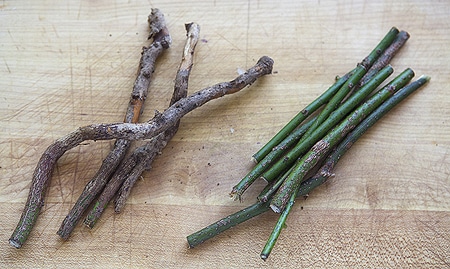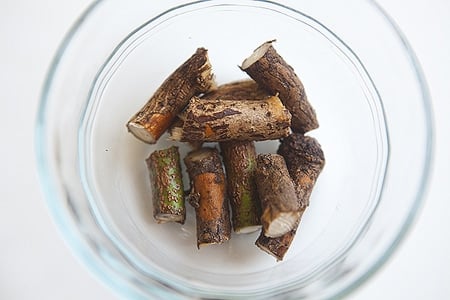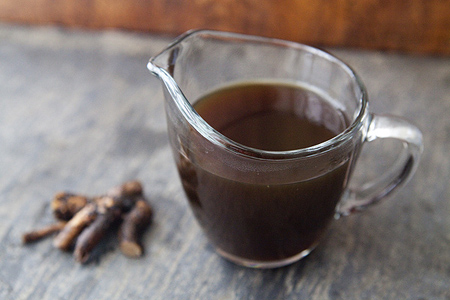As an Amazon Associate I earn from qualifying purchases.

Sassafras. The aromatic bark, leaves and roots of this little tree were believed to be the first plant exported from North America to Europe, back in the late 1500s. All parts of this little tree make for delicious — and different — teas, sweets and other confections, and sassafras commanded exorbitant prices in Europe… until everyone started drinking sassafras tea to cure their syphilis. Soon no one wanted to be seen sipping their syphilis cure in public, and the sassafras trade withered.
More recently, sassafras has been getting a bad rap by the folks at the USDA, who say that the active component of sassafras, safrole, is a “known carcinogen.” Why? They gave tons of pure safrole to rats and the rats got cancer. Later researchers noted that, like the whole saccharine scare in the late 1970s, safrole seems to cause cancer in rats — but not people.
Still, many people still think that sipping sassafras tea or eating sassafras ice cream will doom you to a date with your oncologist. Just know that there are many times more “known carcinogens” in a bottle of beer than there are in any homemade sassafras product you might make. By one calculation, you’d need to drink 24 gallons of sassafras root beer a day for an extended time to get the amount of safrole fed to those rats. And if you drank that much soda, you’d have lots of other problems to deal with…
I collect sassafras on Cape Ann, where my family lives. It’s easy to spot the telltale mitten leaves of the tree. Sassafras is unmistakable: It is a spindly, shrubby tree that lives beneath larger trees. Its upper bark is green, and the leaves come in three varieties, often on the same branch — a mitten, a three-lobed leaf, and a simple spear-shaped leaf.

The way you collect sassafras is to pull seedlings right out of the ground. I know, it sounds destructive, but it isn’t. Sassafras grows in clumps, and the parent tree sends out suckers under the ground, which then become seedlings; it’s a lot like mulberry. You find a clump — look for at least 8 to 10 treelings scattered about — go to one about 2 or 3 feet tall, grasp the very base of the tree and yank it straight up. You should come away with the seedling and about 10 inches’ worth of the root.
You did not get all of the root, you know, and this is a good thing. It will regrow later. So what seems a little wanton is actually good for the sassafras cluster — it lets the surrounding seedlings grow with less competition.
All parts of this tree are useful. Notice I did not say “edible,” because the leaves are the only part you actually eat. You know them as filé powder, and without sassafras leaves gumbo just isn’t gumbo.

Roots on the left, twigs on the right. What’s the difference? They make very different teas. The twigs have a lemony-floral flavor and aroma that one author has compared to Froot Loop cereal — not exactly a selling point in my book, but they are lovely. The roots, however, are the “root” in root beer.
I am not a tea drinker. Coffee is my breakfast drink of choice. So I was not about to switch for sassafras. But I do like using flavored syrups from wild ingredients; I recently made a delicious fir tip syrup from the young tips of a Douglas fir tree. I then use these syrups to glaze meats, make homemade sodas, sorbets or ice creams. Sassafras is a prime candidate for this treatment.
To make the twig syrup, you peel back the green bark a bit to expose it — the bark is what has most of the flavor — then simmered the twigs in hot water. The brew quickly turns a pretty amber, a little like cola. Let it steep overnight and then strain it through cheesecloth and mix it 1:1 with sugar to make a simple syrup. It is outstanding. I mean, really outstanding. Think root beer with a lot of lemon in it.
To make an authentic root beer syrup, the first thing you need to do it chop the sassafras roots.

But root beer is not just sassafras, it is a concoction of many things. My recipe is heavy on the sassafras roots, plus some burdock root, molasses for color, one clove, a star anise, some coriander seed and one drop of wintergreen extract. it really does taste like root beer! Maybe not the root beer you get in a can now, but then that no longer has any real sassafras in it. It is warm, and zingy, and, well, deliciously rooty.
If you live near sassafras trees — and you do if you live east of the Great Plains, south of Quebec and north of Orlando — by all means make this syrup. If you don’t live there, or don’t feel like foraging, you can buy sassafras root bark online. You’ll never go back to store-bought root beer again.

[recipe_name]Homemade Root Beer Syrup[/recipe_name]
[summary]Now I know this is not a traditional root beer. Traditional root beer is brewed with yeast, is mildly alcoholic — and can be tricky to make. This recipe will give you a root beer flavored syrup that tastes amazing, is stable in the fridge for a year, and needs only seltzer water or club soda to become a wonderful homemade root beer.
You will need some unusual ingredients to make this, notably sassafras roots. If you happen to live in the United States east of the Great Plains, you are in luck: Sassafras grows everywhere in that region. If you don’t live there, or don’t feel like foraging for your own sassafras, you can buy sassafras root bark online.
The burdock in the recipe grows all around you as a weed. Otherwise, many good supermarkets have burdock in the produce section: They are long pale, skinny roots often sold under their Japanese name “gobo.” If you absolutely cannot get your hands on burdock, skip it. The root beer will be different, but still fine.
If you can find it, get wintergreen extract. If not, use peppermint extract.
When you make your root beer, start with a tablespoon of this syrup to a pint of seltzer water. You can adjust the strength of your drink from there.[/summary]
[yield]Makes 2 quarts. [/yield]
Prep Time:[preptime time=5M] 5 minutes[/preptime]
Cook Time:[cooktime time=25M] 25 minutes[/cooktime]
- [ingredient][amount]6 cups[/amount] of [item]water[/item] [/ingredient]
- [ingredient][amount]3 ounces[/amount] of [item]sassafras roots[/item][/ingredient]
- [ingredient][amount]1 ounce[/amount] of [item]burdock root[/item][/ingredient]
- [ingredient][amount]1/4 cup[/amount] [item]molasses[/item][/ingredient]
- [ingredient][amount]1[/amount] [item]clove[/item][/ingredient]
- [ingredient][amount]1[/amount] [item]star anise[/item][/ingredient]
- [ingredient][amount]1 teaspoon[/amount] [item]coriander seeds[/item][/ingredient]
- [ingredient][amount]2 drops[/amount] [item]wintergreen extract[/item] or [item]peppermint extract[/item][/ingredient]
- [ingredient][amount]6 cups[/amount] [item]sugar[/item][/ingredient]
____________
[instructions]
- Chop the sassafras and burdock roots into small pieces, about 1/2 inch or smaller.
- Put the roots in a medium-sized heavy pot with the clove, star anise and coriander seeds and cover with the water. Cover the pot and bring it to a boil. Simmer this for 15 minutes.
- Add the molasses and simmer another 5 minutes.
- Turn off the heat and add the wintergreen or peppermint extract. Put the cover back on the tea.
- When the mixture cools, strain it though cheesecloth to remove any debris.
- Return it to the pot with an equal amount of sugar. Stir to combine. Bring it to a simmer and cook it for 5 minutes, uncovered. Pour into quart mason jars and seal. Keeps a year in the fridge.
[/instructions]




Hi Hank… I enjoyed this blog post and I had fun making the syrup with items purchased from Amazon. (There are no sassafras trees in Arizona!) For an alternative use for the syrup, check out my post for making Root Beer Marble Ice Cream. https://www.salvationsisters.com/2011/07/root-beer-marble-ice-cream.html
Wow! Thank you so much. I have a Sassafras tree and didn’t have a clue what to do with it. The yard of this house that we bought is full of useful plants, but the Sassafras had me stumped. We have children and it will be so much fun to make rootbeer for and with them. Thank you again. ?
Wow my Bro used to bring it home to our apartment
when we lived in Dinwiddie Co, VA…..1968.
That’s it! You’ve got to make Dr. Pepper syrup somehow. Keep blowing my mind.
Wintergreen wild grows in the same area as sassafras.
It’s a little hard to spot during the summer but once
the undergrowth has turned brown in the fall it’s
easy to spot. The leaves need to be dried before
use, or so I’ve read. And the berries are eatable.
Howdy Hank,
Just brewed up the twig syrup from some trees in Maryland. Ironically enough, I’m spending this summer on the Sassafras River, so the syrup made sense. Made filé powder a little earlier in the year and had excellent results again. Thank you for maintaining such a wonderful blog on this kind of stuff.
All the best,
Nathan
I love all of this great info! I always wondered what was in root beer… now I know!
Okay, I’m sold. I tried to do root beer the old-fashioned way, with yeast fermentation. Like you, I was astonished to find that my mix tasted just like root beer (we have sassafras and wintergreen on our property). Then the yeast ate the sugar and it tasted like really bad cough syrup. I’m doing it your way from here on in.
Re: safrole. The first rule of toxicology is that the dose is the poison. All the research on safrole involves giving a great deal of it to rats. To draw conclusions about the the impact of the occasional root beer on human health is virtually impossible, but I’d bet we all do riskier things every day.
WOW, I never realized how hard times were in the Shaw household – having to resort to cooking up trees? Blimey..
Seriously though, your blog is unique mate. I don’t know another site out there with such culinary diversity as yours. I am just wondering to get said ingredients up here in Seattle. I would love to give this one a try.
Great photos by Elise BTW.
You know when I was a young girl ( I am 52 now) my Grandmother had us drink sassafras tea just about daily in the spring because she said it was a good tonic for the blood. Grandmother must of been right, we were healthy as can be as kids hahah. My Father would get branches but more often the roots as they are a bit more intense in flavor.
Pam
sgeddings: Thanks for the link, I read it and it is good information to have out there. But again, the poison is in the dose. The safrole in the essential oil of sassafras is the bad actor here. If you’ve ever tried to make an essential oil, you know that it often requires huge amounts — 100+ pounds is not uncommon — just to distill 1 ounce of essential oil.
Now my root beer syrup recipe requires 2 ounces of sassafras root — not just the root bark, which holds most of the safrole — to make 2 quarts of syrup. That syrup is then further diluted, because you need only about 1 tablespoon to make a full pint’s worth of root beer. The mice were fed pure safrole. For me to get even within an order of magnitude of that dosage, I’d need to drink many, many gallons of my root beer every day.
All this said, the Greeks are correct: All things in moderation.
I’m really excited because I live in Massachusetts. I’ll be on the hunt for sassafras very soon. Thanks for posting this. I’ve been reading about the possible harm from them and you’ve calmed my fears.
FYI: The FDA banned the use of sassafras oil not just for being carcinogenic, which I agree with Hank, anything in that large amount is bound to be carcinogenic including black pepper. But sassafras also causes liver damage which has been researched and found to be the safrole component of sassafras oil. https://www.ncbi.nlm.nih.gov/pmc/articles/PMC2504026/?tool=pmcentrez. This is an article that summarizes the research well, just scroll down to Sassafras oil. Then you can make an informed decision for yourself. I happen to be from Louisiana and make gumbo and thus use file powder (ground sassafras leaves). Using it now and again, I don’t consider to be that bad. But just be aware of the dangers before you drink alot of homemade root beer on a regular basis, especially if you have other risk factors for liver damage such as certain prescription drugs and heavy alcohol use.
Amazing! Just found your site through a link on Simply Recipes, and I am loving your style.
Kevin: You are too far north, sadly. But, you can buy it online. Or make cool stuff from up there. I just ordered a copy of a book about Canadian wild food called “The Boreal Gourmet.” Looking forward to it!
Hettar: Good luck with the transplanting – lemme know if it works.
Deana: You live in Jersey, right? It ought to be all over the Watchung Mountains, which isn’t too far from you. You might even find it at Palisades Park.
Garrett: You’ll need to buy the sassafras online, but Whole Foods has the burdock.
That homemade rootbeer was crazy good, Hank. Now I just need to find a place that sells sassafras and burdock roots online.
You can find sassafras in Central Park in NYC. I went on a foraging tour there and got to sniff a bit… I love the idea of root beer from scratch… perhaps in the interest of leaving the park its trees I will buy some… thanks for the recipe!
I just have to chime in here. This root beer that Hank made is OUTSTANDING. Really really really good. Hank made a batch at my house (hence the photos) and left me with a quart of the syrup. My dad came over later and I served him a homemade root beer with the syrup mixed with some soda water. He drank three glasses. Everyone I’ve served this to has looked up with amazement in their eyes at how good it is. I’m headed to Massachusetts in a few weeks and can’t wait to forage around for some sassafras so I can make this root beer for friends out there. If you have access to sassafras I highly recommend giving this one a go, especially if you’re a root beer fan.
I never knew file powder was just sassafrass leaves dried. you learnt me yet again. 🙂
This was a very informative post and I’m excited to try the recipies. I’m going to have to try to find a tree (or a few) to transplant near my house now.
I wish this was kicking about here, but sadly, I do not live where you describe. Those photos of Elise’s are fan-tastic!